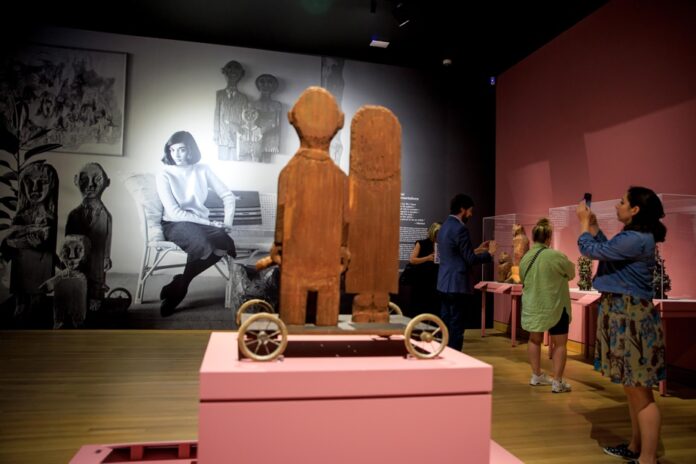Let’s be honest: almost no one had heard of Marisol until her retrospective posters popped up all over town. To make your visit easier, we present to you a short guide that should convince you to give the Museum of Fine Arts a vote of confidence. Because yes, you have to go see this fabulous exhibition.
For the artist herself, little known, but who marked her era by representing the societal issues of the 1950s, 1960s and 1970s, those which still resonate so strongly today. An example: a diver, Marisol included the seabed in part of her work. As much in photos as by these intriguing fish which display her face.
Political, feminist and environmental issues are present in her work, in an intelligently subtle way. The artist avoided satire, broad strokes which lack finesse. Instead, she relied on the good judgment of the people who were going to see her work. Thanks to her.
The curators of this exhibition had the brilliant idea of presenting the works in chronological order. From the 1960s, the artist made magnificent sculptures that are easily tamed by everyone, the large characters presenting multiple levels of reading, but all being very beautiful, almost charming.
This was of course the question on everyone’s lips during the presentation of the exhibition earlier this week. Or rather, why is the Museum of Fine Arts devoting its major fall exhibition to a single, totally unknown artist?
“Exactly for that,” replied the chief commissioner of the Montreal institution, Mary-Dailey Desmarais. She herself had to delve into the work of this artist, whose name she knew, more than the entire work.
“I was completely struck by the uniqueness of Marisol’s practice,” she said. No one else at that time was making life-size sculptures, in wood, with all these drawn elements. As one curator said at the time, no one has deflated human complexity, human arrogance, with as much insight as Marisol. »
Marisol was born in Paris to Venezuelan parents. She had an easy life in terms of material comfort, but very complex emotionally. After witnessing her mother’s suicide, young Marisol locked herself into almost complete silence until adulthood.
She traveled extensively and settled in New York in 1950 as she entered her twenties and defined her artistic practice.
She quickly became a media darling, her famous characters being very unifying among gallery audiences. But the artist evolved towards a less popular style and lost this media attention. His exhibitions were less popular, his works sold less, after his pop art period.
Why then not return to this obviously more universal style?
“Because she’s a great artist! », says Cathleen Chaffee, chief curator of the Buffalo AKG Art Museum which is the organizer of this traveling exhibition, presented for the first time in Montreal.
“This is what makes great artists,” continues the curator. They don’t do their job for the press or for buyers. »
The exhibit opens Saturday, October 7, and the museum is open Thanksgiving Monday.
Our recommendation: go in November. When the city is gray and morale is low.
Marisol is an important pop art artist, this protest movement which knew how to add color and humor to its representation of serious and serious issues. Seeing your journey, as hard as it may be, brings hope and reflections that make you grow.
The Marisol exhibition deserves a good two hours if you want to take the time. To take a step back from the characters and still have enough time for the last rooms which offer less striking works than those at the entrance. To also have time to read the details which reveal the fascinating life of this singular artist.
The retrospective includes more than 250 works in total.
But while you’re at the museum, also stop by the Pop Life! which is presented there until March 2024 and which shows a very local face of the movement.
These two exhibitions, but particularly the one dedicated to Marisol, achieve the almost impossible: unite around what divides.
Maria Sol Escobar was born in Paris in 1930 and died in New York in 2016. She lived in Caracas, New York and Los Angeles and studied at the Paris School of Fine Arts.
His work is initially influenced by pre-Columbian art and abstract expressionist painting. She then rubbed shoulders with Andy Warhol and his entourage in the 1960s – she also represents Warhol in a piece which is part of the retrospective.
Its practice spans nearly 60 years, but it was most popular in the 1950s and 1960s.















